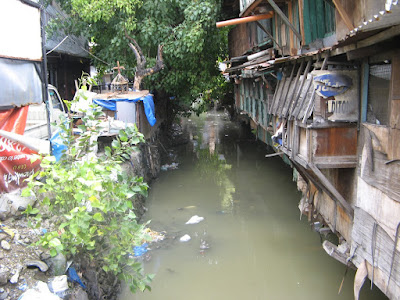RIVIÈRES ... QUEL FUTUR ?
Comment entretenir et protéger
des rivières qui ne se voient pas?
Ce que nous ne pouvons voir nous laisse indifférents!
Ce que nous ne pouvons voir nous laisse indifférents!
C’est ce qui se passe avec de
nombreuses rivières, bras, torrents et ruisseaux qui, dans les grandes villes
philippines, ont été canalisés, recouverts de béton et qui pour certains ne
voient jamais le soleil.
Ce n’est que lors d’inondations,
quand leurs eaux chargées de détritus envahissent rues et habitations, que l’on
découvre qu’une rivière, jusque là souterraine, passe sous les dalles de béton.
What do we know of rivers? Like other city
dwellers, I remember rivers only when, swollen by torrential rain or clogged by
refuse, these overflow and confront us with the detritus of urban life, ranging
from the inconvenient to the tragic.
Alongside reports of metro flashfloods worsened
by unfinished drainage projects ironically called “flood interceptors” are
stories of children who drowned while swimming or after falling into a swollen
river as they were going home from school.
I Googled and found out that nearly all
searches associate rivers with disaster.Trash, not riverine life, dominates six
of Metro Cebu’s major rivers, reported in a newspaper last June 4. Leading the
Guadalupe River in Cebu City, Sapangdaku in Toledo, Guindarohan in Minglanilla,
Luknay in Liloan, and Cansaga in Consolacion is the Butuanon River, classified
as one of the nation’s worst by the Department of Environment and Natural
Resources (DENR) central office.
In some reports, rivers and creeks are left
unnamed as if these waterways were not newsworthy except as sites of
calamities.
Perhaps there lies the tragedy of rivers in our
time.
How many of us retain a memory of rivers before
we despoiled these? How many of us have seen a river without floating garbage,
industrial waste or illegal settlements? How many of us can name a river? Or
want to know its name?
What we cannot name, we cannot care about. What
we cannot feel concern for, we cannot take part in its solution.
I realized this after reading and rereading a
newspaper special report, “Swamped: Flood-proofing Mandaue City.
Basilan reported on the incentives given by
Mandaue politicians, from exchanging groceries for recyclable trash to offering
food-for-work to weed out trash from creeks and rivers. Instead of dole-outs,
local leaders should encourage “bayanihan (self-help volunteerism).” In DENR
river clean-ups, residents simply look on or point out garbage to the
volunteers.
Poet Myke U. Obenieta once planned to compile
the local lore surrounding rivers. His idea predates the Rivers of the World
project. Through a British and Philippine partnership, elementary and high
school students and teachers make artworks capturing the history of local
rivers.
Long before Myke dreamt of following wherever
riverine stories will take him, I detoured from hearing Sunday mass to explore
a “canal” along Mango Ave.
City-bred, we did not have the range of words that
rural children have for natural waterways that are interwoven with their life:
“suba,” “sapa,” and “sapa-sapa.” We thought “canal” was the Cebuano word for
the Mango Ave. waterway that often overflowed, spilling slime and smell; hence,
our name for it.
Later, odorous in our Sunday’s best clothes, we
ogled our catch. Tiny and nearly invisible in the jar of tap water, the “canal”
fish was a creature of wonder.
Before evening, it went belly up.
Our youth deserve better memories of rivers.
Expériences, avis, critiques et commentaires, comme d’habitude sont les bienvenus.
Retrouvez-moi sur :
www.expatauxphilippines.blogspot.com
www.expatauxphilippines.blogspot.com
Les articles de ce blog sont © Copyright protected. Leur reproduction, mise en réseau public ou privé, sous quelque forme sont interdites sans l'accord préalable de l'auteur.
Prendre sa retraite aux Philippines,
Pourquoi ?
7107 îles, plus de 36.000 kilomètres de côtes,
des milliers de plages de sable blanc, le soleil toute l’année ;
des montagnes qui culminent à plus de 3.000 mètres,
des milliers de plages de sable blanc, le soleil toute l’année ;
des montagnes qui culminent à plus de 3.000 mètres,
la jungle, les forêts, des paysages grandioses.
Une population chaleureuse et accueillante, des tribus colorées.
Un excellent service de santé à un prix abordable. Le coût de la vie,
un des plus bas au monde ; de nombreux avantages offerts aux retraités,pas d’impôts ni de taxes.
un des plus bas au monde ; de nombreux avantages offerts aux retraités,pas d’impôts ni de taxes.
Rendez-vous sur la page livres pour en savoir plus.
“Épouser une Femme Philippine”,
sous titré,
Chercher Trouver et Marier une Pinay,
S’adresse à tous les hommes occidentaux qui souhaitent trouver aux pays des 7.107 îles celle qui deviendra la compagne de leur vie.
Un livre complet qui aborde tous les sujets sans tabous.
Plus d’information sur la page ‘’livres’’
Mon petit livre
“101 façons de Générer des Revenus aux Philippines, pour y vivre’’ est maintenant disponible.
Vous trouverez plus d’information sur la page ‘’Livres’’











Comments